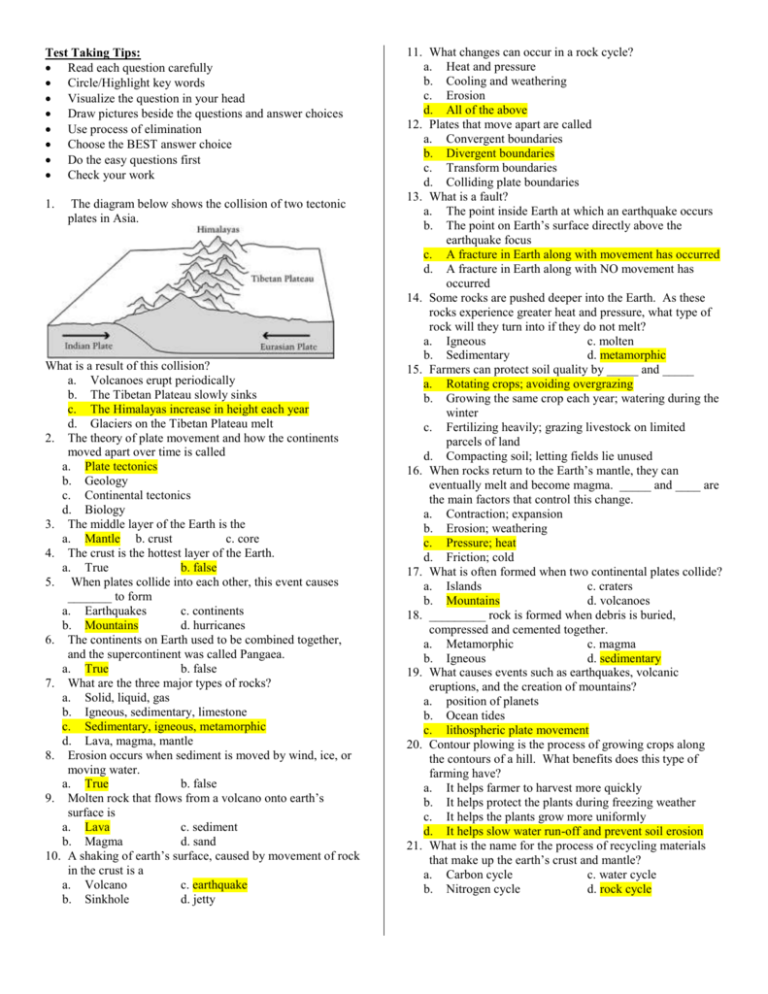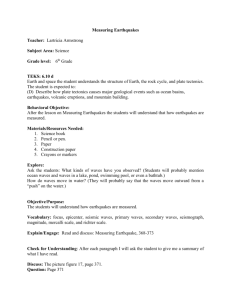Earth Structure Study Guide Answers
advertisement

Test Taking Tips: Read each question carefully Circle/Highlight key words Visualize the question in your head Draw pictures beside the questions and answer choices Use process of elimination Choose the BEST answer choice Do the easy questions first Check your work 1. The diagram below shows the collision of two tectonic plates in Asia. What is a result of this collision? a. Volcanoes erupt periodically b. The Tibetan Plateau slowly sinks c. The Himalayas increase in height each year d. Glaciers on the Tibetan Plateau melt 2. The theory of plate movement and how the continents moved apart over time is called a. Plate tectonics b. Geology c. Continental tectonics d. Biology 3. The middle layer of the Earth is the a. Mantle b. crust c. core 4. The crust is the hottest layer of the Earth. a. True b. false 5. When plates collide into each other, this event causes _______ to form a. Earthquakes c. continents b. Mountains d. hurricanes 6. The continents on Earth used to be combined together, and the supercontinent was called Pangaea. a. True b. false 7. What are the three major types of rocks? a. Solid, liquid, gas b. Igneous, sedimentary, limestone c. Sedimentary, igneous, metamorphic d. Lava, magma, mantle 8. Erosion occurs when sediment is moved by wind, ice, or moving water. a. True b. false 9. Molten rock that flows from a volcano onto earth’s surface is a. Lava c. sediment b. Magma d. sand 10. A shaking of earth’s surface, caused by movement of rock in the crust is a a. Volcano c. earthquake b. Sinkhole d. jetty 11. What changes can occur in a rock cycle? a. Heat and pressure b. Cooling and weathering c. Erosion d. All of the above 12. Plates that move apart are called a. Convergent boundaries b. Divergent boundaries c. Transform boundaries d. Colliding plate boundaries 13. What is a fault? a. The point inside Earth at which an earthquake occurs b. The point on Earth’s surface directly above the earthquake focus c. A fracture in Earth along with movement has occurred d. A fracture in Earth along with NO movement has occurred 14. Some rocks are pushed deeper into the Earth. As these rocks experience greater heat and pressure, what type of rock will they turn into if they do not melt? a. Igneous c. molten b. Sedimentary d. metamorphic 15. Farmers can protect soil quality by _____ and _____ a. Rotating crops; avoiding overgrazing b. Growing the same crop each year; watering during the winter c. Fertilizing heavily; grazing livestock on limited parcels of land d. Compacting soil; letting fields lie unused 16. When rocks return to the Earth’s mantle, they can eventually melt and become magma. _____ and ____ are the main factors that control this change. a. Contraction; expansion b. Erosion; weathering c. Pressure; heat d. Friction; cold 17. What is often formed when two continental plates collide? a. Islands c. craters b. Mountains d. volcanoes 18. _________ rock is formed when debris is buried, compressed and cemented together. a. Metamorphic c. magma b. Igneous d. sedimentary 19. What causes events such as earthquakes, volcanic eruptions, and the creation of mountains? a. position of planets b. Ocean tides c. lithospheric plate movement 20. Contour plowing is the process of growing crops along the contours of a hill. What benefits does this type of farming have? a. It helps farmer to harvest more quickly b. It helps protect the plants during freezing weather c. It helps the plants grow more uniformly d. It helps slow water run-off and prevent soil erosion 21. What is the name for the process of recycling materials that make up the earth’s crust and mantle? a. Carbon cycle c. water cycle b. Nitrogen cycle d. rock cycle 22. Earth’s surface is constantly changing. Volcanoes erupt and form new crust. Lithospheric plate motions bend and crack old crust and cause earthquakes. Where do most of the Earth;s earthquakes and volcanoes occur? a. At the center of continental plates b. Along plate boundaries c. At the equator d. Along hot spots in oceanic crust 23. Which of the following can negatively impact soil quality? a. Careful ranching practices b. Improper disposal of chemicals c. Vegetation d. Crop rotation 24. Lithospheric plates the size of continents and oceans are constantly moving as a result of activity in the Earth’s mantle. Approximately how fast do these plates move? a. A few meters per year b. A few hundred kilometers per year c. A few kilometers per year d. A few centimeters per year 25. What are the two main factors in the mantle that contribute to the rock cycle? a. Layering & pressure c. pressure & heat b. Weathering & layering d. heat & weathering 26. Which of the following is an example of stewardship towards the environment? a. Helping find a lost dog b. Pouring unused medicine down the drain c. Volunteering to help plant trees d. Giving money to charities 27. Earth’s lithospheric plates a. Are constantly in motion c. move once b. Move only up and down d. do not move 28. Which type of rock contains minerals arranged in crystals and forms when molten rock cools and turns solid? a. Sedimentary rock c. fossilized rock b. Metamorphic rock d. igneous rock 29. Soil conservation involves protecting _____ and preventing ______ a. Topsoil; pollution c. soil layers; pollution b. Soil quality; erosion d. soil layers; erosion 30. The point inside the Earth where an earthquake actually begins is called the ____ of the earthquake. a. Fault c. epicenter b. Focus d. seismic wave 31. The buildup and release of stress along a ___ causes most earthquakes a. Mountain range c. fault b. Volcano d. crustal plate 32. The bending of rock layers due to stress is known as a. Faulting c. divergence b. Folding d. convergence 33. When tension pulls rocks apart, it creates a a. Normal fault c. reverse fault b. Mid-ocean ridge d. strike-slip fault 34. When opposing forces cause rock to break and move horizontally, they create a a. b. Normal fault Fold c. reverse fault d. strike-slip fault 35. What is seismology? The study of earthquakes _____________________________ ______________________________________________ 36. Seismic waves that travel through earth’s interior are a. Surface waves c. earth waves b. Body waves d. secondary waves 37. Which of the following is the fastest type of seismic wave? a. Surface waves c. S waves b. Body waves d. P waves 38. Which of the following is another name for S waves? a. Secondary waves c. surface waves b. P waves d. primary waves 39. Another name for a pressure wave is a. Convergent wave c. primary wave b. Surface wave d. secondary wave 40. What is the branch of science in which earthquakes are studied? a. Earthquake science c. seismology b. Tectonics d. wave science 41. How are surface waves different from body waves? a. They are more destructive b. They travel faster c. They travel through the inside of Earth d. They are secondary waves 42. _Fault_______________________________ is the change in shape of rock due to stress. 43. _P waves (pressure/primary waves)_______________ always travel ahead of other waves. 44. The point on Earth’s surface directly above an earthquake’s starting point a. Seismograph c. seismogram b. Epicenter d. focus 45. Instrument that records vibrations in the ground and determines the location and strength of an earthquake a. Seismograph c. seismogram b. Epicenter d. focus 46. Tracing of earthquake motion that is detected by a seismograph a. Seismograph c. seismogram b. Epicenter d. focus 47. The point in earth’s interior where an earthquake begins a. Seismograph c. seismogram b. Epicenter d. focus 48. What do seismologists use to measure earthquake strength? ____Richter Scale_______________________ 49. Most earthquakes occur along the edges of a. Tectonic plates c. seismic gaps b. Wave boundaries d. epicenters 50. New oceanic lithosphere forms as a result of a. Sea-floor spreading c. normal polarity b. Reverse polarity d. continental drift Read each definition in each box. Write the vocabulary word that matches its definition. Word Bank: normal fault, rock cycle, strike-slip fault, surface waves, erosion, transform boundary, seismologist, plate boundary, divergent, sedimentary, metamorphic, lithosphere, S wave, compaction, fault, epicenter, reverse fault, continental drift, Pangaea, deposition, asthenosphere, P wave, folding, seismology, igneous rock, compression, seismograph, focus, weathering, seismogram, seismic wave, convergent, mesosphere Solid layer of the mantle Two tectonic plates collide 2 tectonic plates separate Fault when rock moves horizontally A break in rock that is due to stress mesosphere convergent divergent Strike-slip fault A wave of energy that travels through the earth (body waves) Seismic waves A scientist who studies earthquakes seismologist New oceanic lithosphere forms as magma rises to the surface Layers of sediment are pressed and cemented together sedimentary Rocks push together Rocks pull away from each other Fault when rocks are pulled apart Continents as one single landmass compression tension normal Pangaea Soft layer of the mantle (plastic) The crust and upper mantle Magma or lava that has cooled and solidified The study of earthquakes 2 tectonic plates slide past each other horizontally asthenosphere lithosphere seismology Igneous rock transform Sea-floor spreading A tracing of earthquakes motion The process of when a rock changes because of stress Sediments that have compacted over time Heat and pressure change the rock Moves along earth’s surface slowly more destructive Deformation compaction metamorphic Surface waves Wind, water, or gravity transport soil and sediment from one location to another erosion Water, wind, ice and heat break down rock A place where tectonic plates touch Fastest move back and forth (pressure/primary waves) Rock that melted under intense heat and pressure weathering boundary P waves metamorphic Hypothesis that states that the continents once formed a single landmass Continental drift The point on the earth’s surface directly above an earthquake’s starting point epicenter Sudden, violent shaking of the earth The continual process by which new rock forms from old rock Sediment is deposited in bodies of water Fault when rocks are pushed together Second fastest, moves from side to side (shear/secondary) earthquake Rock cycle deposition Reverse fault S wave Used to record vibration in earth and determines the strength of the earthquake seismograph Bends in rock that are the results of heat and pressure The point inside the earth where the earthquake begins folding focus seismogram








